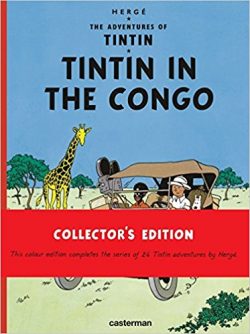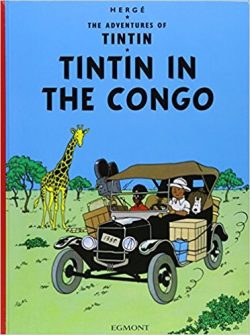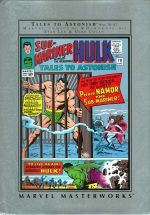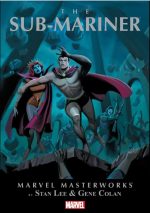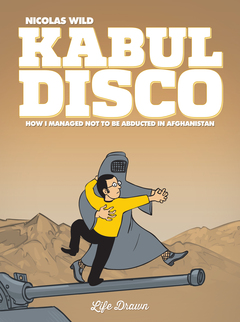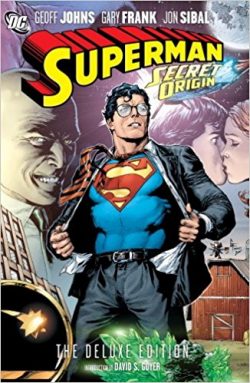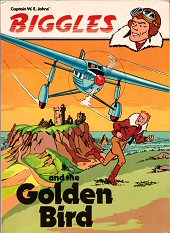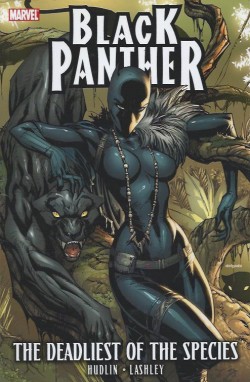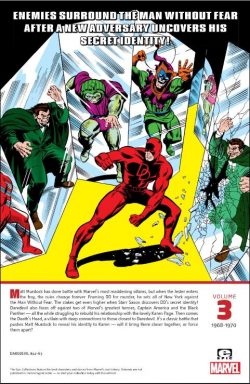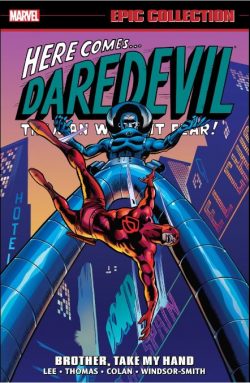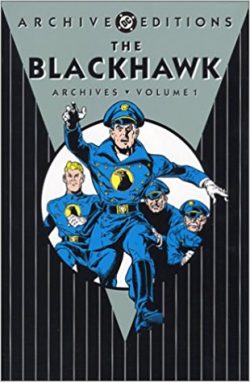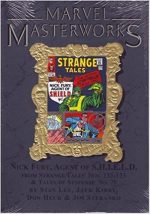
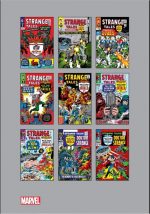
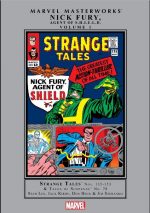
By Stan Lee, Jack Kirby, Dennis O’Neil, Roy Thomas, John Severin, Joe Sinnott, Don Heck, Howard Purcell, Ogden Whitney, John Buscema, Joe Sinnott, Jim Steranko & various (Marvel)
ISBN: 978-0-7851-2686-7 (HB)
Veteran war-hero and superspy Nick Fury debuted in Fantastic Four #21 (cover-dated December 1963): a grizzled, world-weary and cunning CIA Colonel at the periphery of the really big adventures in a fast-changing world.
What was odd about that? Well, the gruff, crudely capable combat everyman was already the star of the minor publisher’s only war comic, set twenty years earlier in (depending on whether you were American or European…) the beginning or middle of World War II.
Sgt. Fury and his Howling Commandos was an improbable, decidedly over-the-top and raucous combat comics series, similar in tone to later movies such as The Wild Bunch or The Dirty Dozen and had launched in May of that year.
Nevertheless, Fury’s latter-day self soon emerged as a big-name star once espionage yarns went global in the wake of popular TV sensations like The Man from U.N.C.L.E. and the elder iteration was given a second series beginning in Strange Tales #135 (cover-dated August 1965).
Nick Fury, Agent of S.H.I.E.L.D. combined Cold War tensions with sinister schemes of World Conquest by a subversive, all-encompassing, hidden enemy organisation. The unfolding saga came with captivating Kirby-designed super-science gadgetry and – eventually – iconic and game-changing imagineering from Jim Steranko, whose visually groundbreaking graphic narratives took the comics art form to a whole new level…
For those few brief years with Steranko in charge, the S.H.I.E.L.D. series was one of the best strips in America – if not the world – but when the writer/artist left just as the global spy-fad was fading, the whole concept faded into the background architecture of the Marvel Universe…
This astounding full-colour compendium (available in hardcover and digital editions) deals with the outrageous, groundbreaking, but still notionally wedded-to-mundane-reality iteration which set the scene.
Here Jack Kirby’s genius for graphic wizardry and gift for dramatic staging mixed with Stan Lee’s manic melodrama to create a tough and tense series which the new writers and veteran artists that followed turned into a non-stop riot of action and suspense, with Steranko’s late arrival only hinting at the magic to come…
These epic early days of spycraft encompass Strange Tales #135-153 and Tales of Suspense #78, collectively covering August 1965 to February 1967 and guaranteeing timeless thrills for lovers of adventure and intrigue.
Following a little history lesson from Kirby scholar John Morrow in his Introduction, the main event starts with ST #135 as the Human Torch solo feature is summarily replaced by Nick Fury, Agent of S.H.I.E.L.D. – which back then stood for Supreme Headquarters International Espionage Law-enforcement Division…
In the rocket-paced first episode, Fury is asked to volunteer for the most dangerous job in the world: leading a new counter-intelligence agency dedicated to stopping secretive subversive super-science organisation Hydra. With assassins dogging his every move, the Take-Charge Guy with the Can-Do Attitude quickly proves he is ‘The Man for the Job!’ in a potent twelve-page thriller from Lee, Kirby & Dick Ayers.
Even an artist and plotter of Kirby’s calibre couldn’t handle another strip at that busiest of times, so from the next issue “The King†cut back to laying out episodes, allowing a variety of superb draughtsmen to flesh out the adventures. Even so, there’s probably a stunning invention or cool concept on almost every page that follows…
‘Find Fury or Die!’ brought veteran draughtsman John Severin back to the company; pencilling and inking Kirby’s blueprints as the new Director becomes the target of incessant assassination attempts and we are introduced to masked maniac the Supreme Hydra…
The tension ramps up for the next instalment as a number of contenders are introduced – any of whom might be the obscured overlord of evil – even as S.H.I.E.L.D. strives mightily but fails to stop Hydra launching its deadly Betatron Bomb in ‘The Prize is… Earth!’
Despite the restrictions of the Comics Code, these early S.H.I.E.L.D. stories were stark and grim and frequently carried a heavy body count. Four valiant agents died in quick succession in #137 and the next issue underscored the point in ‘Sometimes the Good Guys Lose!’ with further revelations of Hydra’s inner workings.
Fury and fellow Howling Commando war heroes Dum-Dum Dugan and Gabe Jones meanwhile played catch-up after Hydra assassins invade S.H.I.E.L.D.: almost eliminating Fury and munitions genius Tony Stark – the only man capable of destroying the nuclear sword of Damocles hanging over the world. Although Nick saves the inventor, he is captured in the process…
Tortured by Hydra in #139’s ‘The Brave Die Hard!’ (with Joe Sinnott replacing Severin as finisher), Fury finds an unlikely ally in Laura Brown: Supreme Hydra’s daughter and a young woman bitterly opposed to her father’s megalomaniacal madness.
Even with only half a comicbook per month to tell a tale, creators didn’t hang around in those halcyon days and #140 promised ‘The End of Hydra!’ (by Don Heck & Sinnott over Kirby) as a S.H.I.E.L.D. squad invades the enemy’s inner sanctum to rescue the already-free-and-making-mayhem Fury. In the meantime, Stark travels into space to remove the Betratron Bomb with his robotic Braino-Saur system. The end result leaves Hydra temporarily headless…
Strange Tales #141 has Kirby return to full pencils (inked by Frank Giacoia pseudonymously moonlighting as Frank Ray) for the mop-up before ‘Operation: Brain Blast!’ introduces Mentallo – a renegade from S.H.I.E.L.D.’s ESP division – who joins with technological savant the Fixer to attack the organisation as the first step in an ambitious scheme to rule the world.
The momentous raid begins in ‘Who Strikes at… S.H.I.E.L.D.?’ (illustrated by Kirby with Mike Demeo – AKA Esposito) with the deadly rogues hitting hard and fast: seizing and mind-controlling Fury before strapping him to a mini-H-bomb. With Howard Purcell & Esposito embellishing Kirby’s layouts, Dugan and the boys come blasting in ‘To Free a Brain Slave’ in #143…
A new and deadly threat emerges in #144 as ‘The Day of the Druid!’ as a mystic charlatan targets Fury and his agents with murderous flying techno-ovoids. Happily, new S.H.I.E.L.D. recruit Jasper Sitwell is on hand to augment the triumphant fightback in ‘Lo! The Eggs Shall Hatch!’ (finished by Heck & Esposito).
As Marvel continuity grew evermore interlinked, ‘Them!’ details a Captain America team-up for Fury in the first of the Star-Spangled Avenger’s many adventures as a (more-or-less) Agent of S.H.I.E.L.D.
Taken from Tales of Suspense #78 (June 1966): scripted by Lee with Kirby full pencils and Giacoia inks, the story depicts the WWII wonders battling an artificial assassin with incredible chemical capabilities, after which Nick seeks the creature’s mysterious makers in Strange Tales #146, ‘When the Unliving Strike!’ (Kirby, Heck & Esposito).
Proclaiming themselves a technological Special Interests group, Advanced Idea Mechanics courts S.H.I.E.L.D.’s governmental and military masters, promising potent and incredible new weapons if only they sacked that barbaric slob Fury, but the surly supremo is getting close to exposing A.I.M.’s connection to “Them†and an old enemy thought long gone…
A concerted whispering campaign and “briefing-against†seemingly sees Fury ousted in ‘The Enemy Within!’ and put on trial in ‘Death Before Dishonor!’ (scripted by Kirby with Heck & Esposito finishing his layouts), but it’s all part of a cunning counter-plan which delivers a shattering conclusion and ‘The End of A.I.M.!’ in #149 (scripted by Denny O’Neil, with art by Kirby & Ogden Whitney).
Then, revealed by Lee, Kirby, John Buscema & Giacoia, a malign and devilishly subtle plan is finally exposed in Strange Tales #150 as Fury’s team puts together clues from all the year’s past clashes to come to one terrifying conclusion: ‘Hydra Lives!’…
The shocking secret also hints at great events to come as newcomer Steranko assumes the finisher’s role over Lee & Kirby for ‘Overkill!’ with Fury targeted by the new Supreme Hydra who devises a cunning scheme to infiltrate America’s top security agency and use his enemy as the means of triggering global Armageddon…
Although the Good Guys seemingly thwart that scheme, ‘The Power of S.H.I.E.L.D.!’ is actually helpless to discern the villain’s real intent as this initial dossier of doom ends on a cliffhanger after ‘The Hiding Place!’ (ST #153 and scripted by Roy Thomas) closes with the arch villain comfortably ensconced in Fury’s inner circle and ready to destroy the organisation from within…
To Be Continued…
Although the S.H.I.E.L.D. saga stops here, there’s an added bonus still to enjoy: the aforementioned FF #21. This revealed Fury as a wily CIA agent seeking the team’s aid against a sinister demagogue called ‘The Hate-Monger’ (Lee & Kirby, inked by comics veteran George Roussos, under the protective nom-de-plume George Bell) just as the 1960s espionage vogue was taking off, inspired by James Bond films and TV shows like Danger Man.
Here Fury craftily manipulates Marvel’s First Family into invading a sovereign nation reeling in the throes of revolution in a yarn crackling with tension and action…
Fast, furious and fantastically entertaining, these high-octane vintage yarns are a superb snapshot of early Marvel Comics at their creative peak and should be part of every fanboy’s shelf of beloved favourites.
Don’t Yield! Back S.H.I.E.L.D.!
© 1965, 1966, 1967, 2018 Marvel Characters, Inc. All rights reserved.

